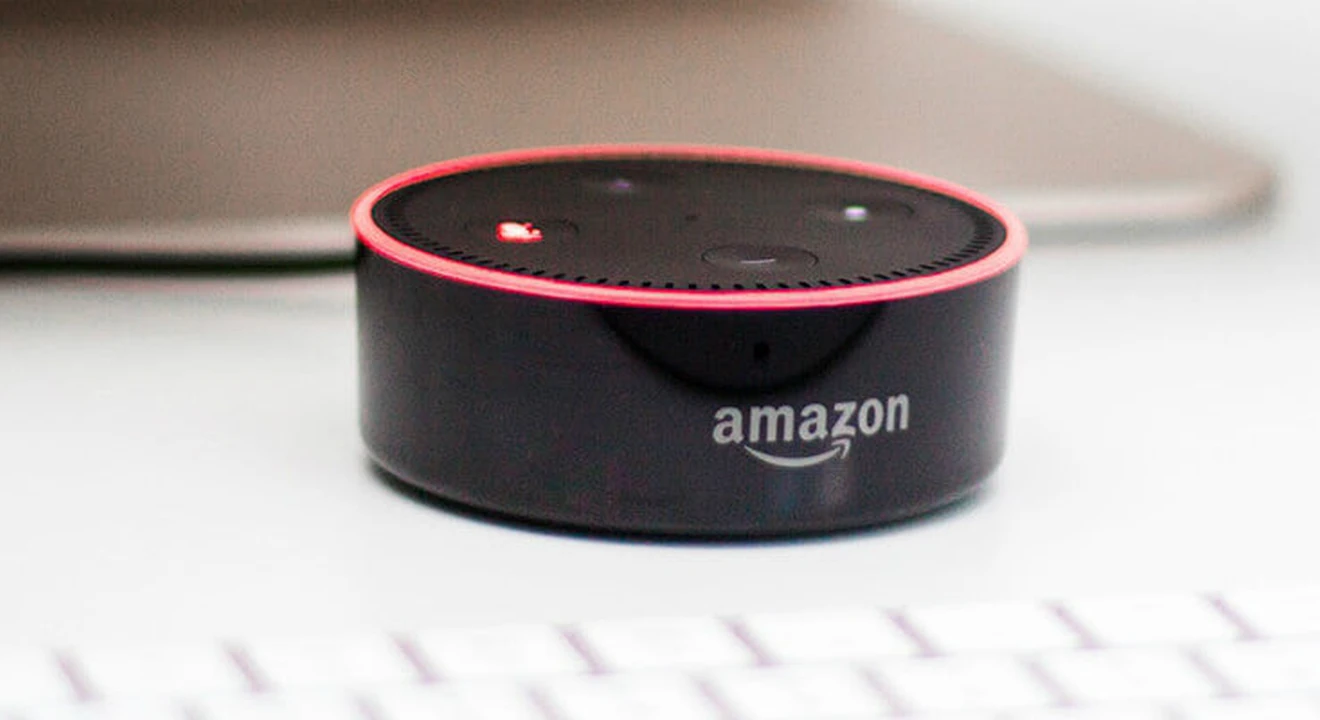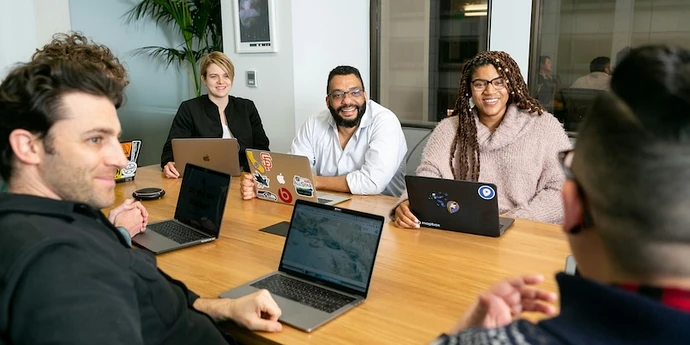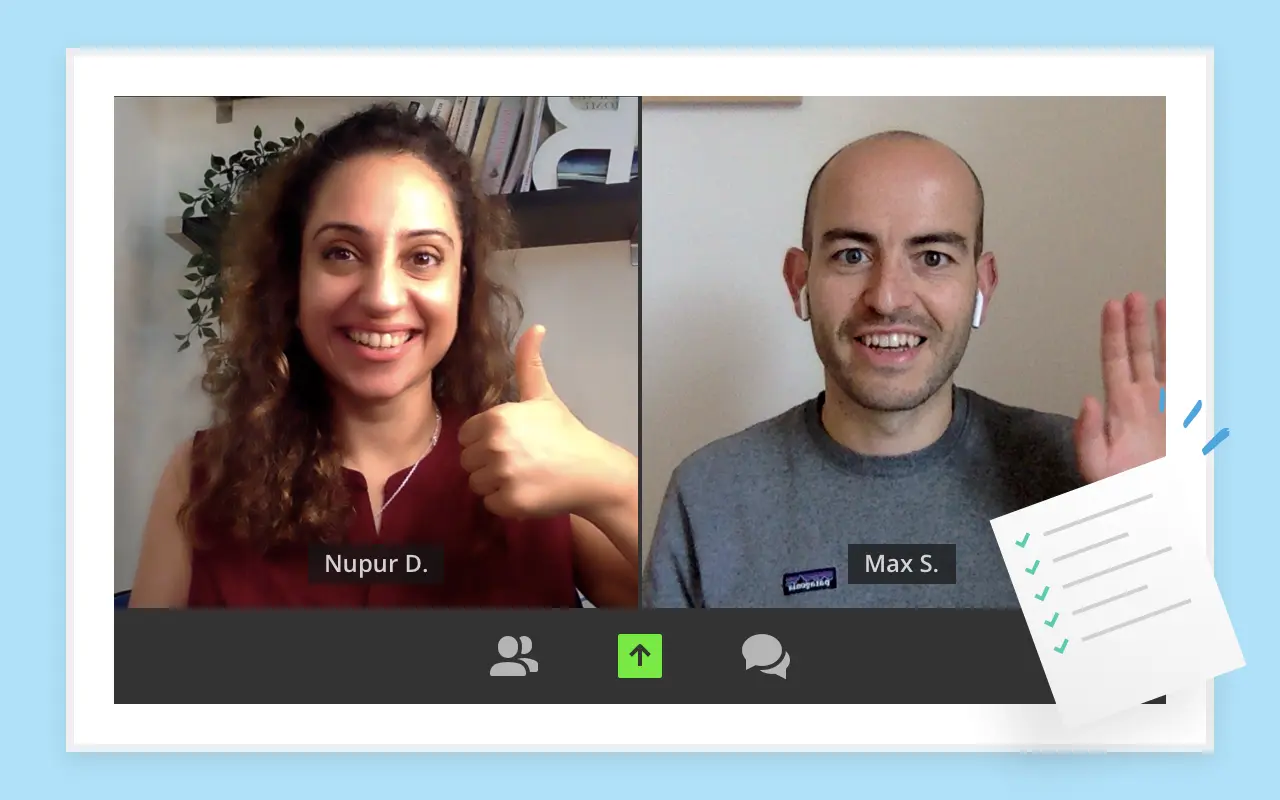Product manager interviews at Amazon are quite different from interviews at other FAANG companies. They focus almost exclusively on behavioral questions.
They want to see that your way of working aligns with their 16 Leadership Principles, with a particular focus on ownership and customer obsession.
Because it’s not as technical as other FAANG PM interviews, you might think you can just walk in and improvise. But based on the candidate reports we’ve analyzed, it’s rarely as simple as it sounds.
Still, there’s no need to worry. The right preparation can make all the difference.
That’s why we’ve written this comprehensive guide. To put it together, we talked with former Amazon PMs and reviewed reports from real Amazon candidates.
Below, you’ll find a detailed breakdown of the interview process, some sample questions, and expert tips—everything you need to walk into each round with confidence.
Click here to practice with Amazon PM ex-interviewers
Let's get started.
1. Amazon product manager role and salary↑
Before we cover your PM interviews at Amazon, let's take a quick look at the role itself (alternatively, feel free to skip straight to the sections on the interview process or interview questions).
1.1 What does an Amazon product manager do?
As an Amazon product manager, your main objective is to develop customer-centric products and features while pushing forward the company’s strategic goals.
You’ll work with cross-functional teams from ideation and conception to execution. Some of your tasks include creating product development specs, creating marketing plans and market segments, developing business models, coming up with the right success metrics, and more.
Being customer-centric is a top trait Amazon candidates need to possess, especially for a PM. As Nishant (ex-Amazon product manager) says, "The most important job for a PM is to be the voice of the customer in all internal discussions and meetings."
Because of Amazon’s top-down decision-making structure, you won’t have as much control over products you ship (unlike at Google and Meta). This requires you to deal with leaders who will have their own strategic priorities, risk tolerance levels, and operational concerns to manage.
"The role of an Amazon PM not only involves idea generation, but also extends to include exceptional persuasive skills, internal lobbying, and relationship management to secure the necessary support," Nishant says.
Product manager (PM) vs. Product manager - technical (PM-T)
Broadly speaking, Amazon has two product roles: Product Managers (PMs) and Product Managers - Technical (PM-Ts).
PMs work for the e-commerce arm of the company and tend to come from a wide range of backgrounds. You don't need to have a technical background to be a PM at Amazon, like you usually would at Google.
PM-Ts work on more technical products such as AWS. To qualify as a PM-T, you’re required to have deeper technical knowledge. Having a background in computer science or engineering will make you stand out for the role.
1.2 How much does an Amazon product manager earn?
Amazon product managers make 37% more than other PMs in the US on average, according to Glassdoor.
Below is the average salary and compensation of the different product manager levels at Amazon. This is based on the reported data from Levels.fyi as of April 2025.

If you’re unsure what level you’re being considered for, ask your recruiter.
Ultimately, how you do in your interviews will determine what level you’re offered. That’s why hiring one of our Amazon PM interview coaches can provide such a significant return on investment.
And remember, compensation packages are always negotiable, even at Amazon. So, if you do get an offer, don’t be afraid to ask for more.
Read our guide on Amazon job offer negotiation and PM salary negotiation guide for some practical tips. If you need some expert help practicing what you’ve learned, consider booking one of our salary negotiation coaches.
2. Amazon product manager interview process and timeline ↑
What's the interview process at Amazon for the product manager role?
The good news is that Amazon works a bit quicker than the other FAANG companies. The process takes four to six weeks on average and follows these steps.
- Resume screen
- Phone screen
- Written assessment
- Interview loop
Note that the process at AWS follows similar steps.
If you are interviewing for a product leadership position (VP, Director, Group PM), check out our product leader interview guide.
Now, let’s take a look at each step in detail.
2.1 Steps to expect
2.1.1 Resume screen
First, recruiters will look at your resume and assess if your experience matches the open position.
This is the most competitive step in the process—we’ve found that ~90% of candidates don’t make it past this stage.
If you’re currently polishing your resume or writing one, read our product manager resume guide. It includes examples from real PMs plus a template to help you get started.
You can also take a look at our Amazon resume guide for more real examples of resumes that got interviews at Amazon.
If you’re looking for expert feedback, you can also get input from our team of ex-Amazon recruiters. They’ll cover which achievements to focus on (or ignore), how to fine-tune your bullet points, and more.
2.1.2 Phone screen
Your phone screen will last 60 minutes. It will typically be with senior members of the product team, including the hiring manager leading your recruitment.
The first half of the phone screen will consist of questions related to Amazon’s Leadership Principles. The next part will be on your PM experience and knowledge.
If you’re applying for the Product Manager - Technical (PM-T) role, the second half of your phone screen will be an assessment of your technical product lifecycle knowledge.
There’s usually only one phone screen. But depending on the role and team, you might be invited for a second one.
Once you clear this round, a recruiter will get in touch and schedule you for an interview loop. They’ll also likely send you instructions for a writing assessment.
2.1.3 Writing assessment
Amazon is known for its writing culture. PMs, in particular, draft a 6-page PR/FAQ (press release/frequently asked questions) document to propose a product idea.
So it should come as no surprise that writing a document is included in their interview process.
Your recruiter will usually give you the writing assessment to complete 48 hours before your interview loop.
Interviewers at your onsite interviews should have read your writing assessment. They may even discuss it during your interview, so best to be prepared for that.
Need help with your writing assessment? Book one of our Amazon PM coaches for take-home assignment advice.
2.1.4 Interview loop
The next step is the interview loop, where you'll participate in ~5 interviews. It can either be on-site in one of Amazon's offices or virtual.
Each interview in the loop usually lasts ~55 minutes. It will be with a mix of people from the team you’re applying to join, including peers, the hiring manager, and a senior executive.
Each interview will focus on 2-3 Leadership Principles. It will also cover product management and stakeholder management skills.
And, if you’re interviewing for the PM-T role, some rounds will include technical questions, just like your phone screen.
One of your last interviews in the loop will be with the Amazon Bar Raiser.
This interviewer is not associated with the team you’re applying for. They focus more on overall candidate quality than specific team needs. They’re trained to make sure Amazon’s hiring standards stay high and don’t degrade over time, so they are a big barrier between you and a job offer.
Click here to learn more about the Amazon bar raiser interview.
2.2 What happens behind the scenes
Your recruiter is leading the process and taking you from one stage to the next. Here's what happens at each of the stages described above:
- After the phone screen, your hiring manager decides whether to move you to the interview loop or not, depending on how well you've done up to that point.
- During the interview loop, interviewers will assess if you’ve got the right role-related skills. They’ll also assess your culture fit using the Amazon Leadership Principles, with the help of a Bar Raiser.
- The Bar Raiser oversees the deliberation, playing a crucial role in the group’s final decision.
- Your recruiter should be in touch within 5 days of your interview loop, either with an offer or to break the bad news.
It's also important to note that recruiters and people who refer you have little influence on the overall process. They can help you get an interview at the beginning, but that's about it.
3. Amazon product manager example interview questions ↑
As we mentioned at the start of this guide, Amazon interviews focus almost exclusively on behavioral or "STAR" questions.
We know this because, aside from talking to Amazon PM ex-interviewers, we've analyzed hundreds of questions reported by former PM candidates on Glassdoor.com since 2021.
3.1 Behavioral
If you’re applying for the PM role, you can expect most, if not all, of your interviews to be behavioral ones.
Behavioral questions are designed to dive deep into how you’ve handled past situations in order to predict your future performance.
You’ll mostly be tested on your alignment with their Leadership Principles, along with your product and stakeholder management skills.
Here we’ve divided the questions into the three categories, but keep in mind that there may be some overlap.
For example, answering “Tell me about a time when you leveraged customer insights/data to drive an improvement” is all about customer obsession. But it will also cover how you make data-driven decisions—an important PM skill.
Another example: “Tell me about a time when you went against your team. What happened?” is about the LP, “Have backbone; disagree and commit,” but it will also assess your stakeholder management skill.
3.1.1 Amazon Leadership Principles
The Leadership Principles tie into every step of the Amazon interview process, and interviewers will test your affinity with them through behavioral questions.

PM interviews tend to focus on the first four LPs, but the rest may also come up at any point during the interview loop.
- Customer Obsession - "Leaders start with the customer and work backwards. They work vigorously to earn and keep customer trust. Although leaders pay attention to competitors, they obsess over customers.”
- Ownership - "Leaders are owners. They think long term and don’t sacrifice long-term value for short-term results. They act on behalf of the entire company, beyond just their own team. They never say ‘that’s not my job."
- Bias for Action - "Speed matters in business. Many decisions and actions are reversible and do not need extensive study. We value calculated risk-taking.”
- Have Backbone; Disagree and Commit - "Leaders are obligated to respectfully challenge decisions when they disagree, even when doing so is uncomfortable or exhausting. Leaders have conviction and are tenacious. They do not compromise for the sake of social cohesion. Once a decision is determined, they commit wholly.”
- Invent and Simplify - "Leaders expect and require innovation and invention from their teams and always find ways to simplify. They are externally aware, look for new ideas from everywhere, and are not limited by ‘not invented here.’ Because we do new things, we accept that we may be misunderstood for long periods of time.”
- Dive Deep - "Leaders operate at all levels, stay connected to the details, audit frequently, and are skeptical when metrics and anecdote differ. No task is beneath them.”
- Are Right, A Lot - "Leaders are right a lot. They have strong judgment and good instincts. They seek diverse perspectives and work to disconfirm their beliefs.”
- Deliver Results - "Leaders focus on the key inputs for their business and deliver them with the right quality and in a timely fashion. Despite setbacks, they rise to the occasion and never settle.”
- Think Big - "Thinking small is a self-fulfilling prophecy. Leaders create and communicate a bold direction that inspires results. They think differently and look around corners for ways to serve customers.”
- Hire and Develop the Best - "Leaders raise the performance bar with every hire and promotion. They recognize exceptional talent, and willingly move them throughout the organization. Leaders develop leaders and take seriously their role in coaching others. We work on behalf of our people to invent mechanisms for development like Career Choice.”
- Frugality - "Accomplish more with less. Constraints breed resourcefulness, self-sufficiency, and invention. There are no extra points for growing headcount, budget size, or fixed expense.”
- Learn and Be Curious - "Leaders are never done learning and always seek to improve themselves. They are curious about new possibilities and act to explore them.”
- Insist on the Highest Standards - "Leaders have relentlessly high standards — many people may think these standards are unreasonably high. Leaders are continually raising the bar and drive their teams to deliver high quality products, services, and processes. Leaders ensure that defects do not get sent down the line and that problems are fixed so they stay fixed.”
- Earn Trust - “Leaders listen attentively, speak candidly, and treat others respectfully. They are vocally self-critical, even when doing so is awkward or embarrassing. Leaders do not believe their or their team’s body odor smells of perfume. They benchmark themselves and their teams against the best.”
- Strive to be Earth’s Best Employer - “Leaders work every day to create a safer, more productive, higher performing, more diverse, and more just work environment. They lead with empathy, have fun at work, and make it easy for others to have fun. Leaders ask themselves: Are my fellow employees growing? Are they empowered? Are they ready for what's next? Leaders have a vision for and commitment to their employees' personal success, whether that be at Amazon or elsewhere.”
- Success and Scale Bring Broad Responsibility - “We started in a garage, but we're not there anymore. We are big, we impact the world, and we are far from perfect. We must be humble and thoughtful about even the secondary effects of our actions. Our local communities, planet, and future generations need us to be better every day. We must begin each day with a determination to make better, do better, and be better for our customers, our employees, our partners, and the world at large. And we must end every day knowing we can do even more tomorrow. Leaders create more than they consume and always leave things better than how they found them.”
In most cases, your recruiter will inform you which Amazon LP to focus on at each stage. You can also infer them from the job description.
Let’s take a look at some examples.
Amazon product manager interview questions: Leadership principles
Customer obsession
- How have you measured customer satisfaction in the past?
- Tell me about a time you said no to a customer request and why.
- Tell me about a time when you leveraged customer insights/data to drive an improvement.
Ownership
- Give an example of a project you took full ownership of and what the outcome was.
- Tell me about a time you designed a plan and failed to execute it. Why did you fail?
- Describe a time when you had to make a difficult decision.
Bias for action
- Tell me about the time when you did something for your project that wasn't asked for or required but still benefited you.
- Tell me about a time when you took a calculated risk and what the outcome was.
- Tell me about a time you had to make a decision with incomplete information. How did you make it? What was the outcome?
Have backbone; disagree and commit
- Tell me about a time you disagreed with a manager.
- Tell me about a time when you tried to convince your manager of a product direction, and were unsuccessful at it.
- Tell me about a time when you went against your team. What happened?
Check out our interview guide on Amazon Leadership Principles to learn more.
3.1.2 Product management skills
In most cases, you’ll get behavioral questions that cover both your LP alignment and product management skills and experience.
Interviewers will be on the lookout for general product management competencies, i.e. knowledge of product lifecycle and methodologies, as well as industry insights.
They’ll also evaluate your problem-solving, prioritization, communication, and cross-functional collaboration skills.
Amazon is a very data-driven company. They’ll want to know what tools you use and how you’ve leveraged data to make decisions in your previous roles.
Make sure to highlight your customer obsession when asked about your PM experience. Emphasize your user-centric approach to product development.
Let’s take a look at some example questions:
Amazon product manager interview questions: Product management skills
- Why product management?
- How do you currently measure product success? What metrics do you track?
- Describe a time when you dealt with multiple sources of data to solve a problem.
- Tell me about a time when you had to make a difficult decision with incomplete information.
- Tell me about a time when you gave a simple solution to a complex problem.
3.1.3 Stakeholder management skills
As we’ve noted in Section 1, Amazon PMs are expected to have strong stakeholder management skills.
You’ll be assessed on how well you’ve handled stakeholder partnerships and negotiations. In particular, you’ll want to highlight successful partnerships where you were able to get buy-in and support from various stakeholders.
You will also be evaluated on how well you create a trusting relationship with peers, and how you can influence others without authority.
Answering these questions, emphasize your affinity for the “Have backbone; disagree and commit” LP.
However, you don’t want to come off as someone who bulldozes everyone. Try to come up with stories where you’ve made sure that the outcome was mutually beneficial for everyone.
Let’s get into some example questions.
Amazon product manager interview questions: Stakeholder management skills
- Can you tell me about a time you had to deal with a difficult client?
- Tell me about a time when you made a difficult decision with input from many different sources (customers, stakeholders, partner teams, etc.). What was the situation, and how did you arrive at your decision? Did the decision turn out to be the correct one?
- Describe a time when you brought different perspectives together to solve a problem. What types of perspectives were represented? How did you seek them out? What was the outcome? Were there any key learnings from this experience? Knowing what you know now, would you have done anything differently?
- Tell me about a time when you successfully influenced someone to reconsider their approach to a problem or project.
Behavioral answer framework
When answering behavioral questions, you should always use an answer framework.
Amazon recommends the STAR (Situation-Task-Action-Result) framework. Here’s a PDF from them where it’s laid out for you.
Using the STAR framework is fine. However, experience has shown us it's not necessarily the optimal approach.
Why not? Because candidates often find it difficult to distinguish the difference between task and action.
Plus, many also forget to include Lessons learned, which is often the most crucial part of the answer.
So we’ve developed the SPSIL (Situation, Problem, Solution, Impact, Lessons) method to correct some of the pitfalls we’ve observed when using the STAR method.
Let’s step through our suggested five-step approach:
SPSIL (Situation, Problem, Solution, Impact, Lessons) Method
- Situation: Start by giving the necessary context of the situation you were in. Describe your role, the team, the organization, the market, etc. You should only give the minimum context needed to understand the problem and the solution in your story. Nothing more.
- Problem: Outline the problem you and your team were facing.
- Solution: Explain the solution you came up with to solve the problem. Step through how you went about implementing your solution, and focus on your contribution over what the team / larger organization did.
- Impact: Summarize the positive results you achieved for your team, department, and organization. As much as possible, quantify the impact.
- Lessons: Conclude with any lessons you might have learned in the process.
You’ll notice that this method covers very similar themes to the STAR method.
A lot of the candidates we work with find this framework easier to use, as there’s no overlap between any of the steps in your story.
That said, you should practice using whatever method you’re the most comfortable with.
Take a look at our Amazon behavioral interview guide, where we outline the SPSIL method in detail and provide sample answers.
3.2 Technical questions (for PM-Ts)
If you're applying for a Product Manager - Technical position, you'll face plenty of technical questions.
In fact, some PM-T interviews can be just as technical as a Software Development Manager interview.
According to Nishant, PM-Ts are required to understand architectural choices and defend them.
So, you can expect to face at least one system design interview. However, you will not face any coding interviews.
You may also be asked to explain technical concepts relevant to the team you may be joining. For instance, if you're interviewing for an AI-focused PM role, expect questions around AI/machine learning basics.
Here are some example questions.
Amazon product manager interview questions: Technical
- Explain ACID transactions
- Describe how to implement a scalable web service architecture, like Amazon.com
- For AWS roles: What is virtualization?
Check our guide on how to answer PM technical questions to learn more.
4. Amazon product manager interviewing tips ↑
You might be a great product manager with excellent stakeholder management skills, but unfortunately, that’s not enough to ace your interviews at Amazon.
Let’s look at some key tips to make sure you approach your interviews in the right way.
4.1 Make sure your answers are data-driven and fact-based
Use specific numbers and metrics in your answers, without breaking confidentiality laws. Amazon is a highly data-driven company, so make sure your answers are too.
4.2 Don’t get stuck in a framework
Using a framework offers a structured approach to answering questions. However, some of our successful candidates have mentioned that excessive reliance on frameworks may hinder your performance.
During the interview, trust your instinct, and don’t be afraid to deviate from the framework if needed. A framework is there to help you craft a better answer, after all.
4.3 Think before speaking
Feel free to pause or request a few minutes to think before proceeding. Organize your thoughts before answering so you can avoid making hasty conclusions.
4.4 Treat the interview like a conversation
Remember that the interview is part of a mutual discovery process.
The interviewer is there to determine if you’re a good fit for Amazon, while you’re also evaluating if the company aligns with your aspirations and preferences.
4.5 Study the Amazon Leadership Principles properly
You don’t necessarily need to memorize all of them, but you’ll still want to have a good understanding of each principle.
Most importantly, you’ll need to prepare enough stories from your previous roles. With some adaptation, you can cover all the LPs and have numerous stories relevant to the all-important first four.
4.6 Save questions for your interviewer
At the end of the interview rounds, you’ll have a few minutes to ask questions to your interviewer. Coming without any questions may suggest a lack of interest in the company or the role.
Think of thoughtful questions and avoid those that you could have easily searched online. For example, you can ask about opportunities for career progression or what methodologies the team uses.
5. Preparation plan ↑
Now that you know what's required of you, let's focus on how you can get there.
Below, you’ll find links to free resources and four introductory steps to help you prepare for your Amazon PM interviews.
5.1 Deep dive into the role/organization
Most candidates fail to do this. But before investing tens of hours preparing for an interview at Amazon, you should take some time to make sure it's actually the right company for you.
Amazon is prestigious and it's tempting to assume that you should apply, without considering things more carefully.
But it's important to remember that the prestige of a job alone won't make you happy in your day-to-day work. It's the type of work and the people you work with that will.
If you know anyone who works or has worked at Amazon, take the time to ask them about the culture at work. Reflect if its values align with yours.
Here are some more resources you can start your deep dive with:
- Amazon annual reports, proxies, and shareholder letters (by Amazon)
- Amazon strategy study (by Cascade)
- Amazon vision and mission analysis (by Panmore Institute)
- The product model at Amazon (by Silicon Valley Product Group)
- Amazon’s working backwards method (by Product Plan)
5.2 Practice by yourself
As we’ve established in this guide, your Amazon PM interview will mostly consist of behavioral questions.
To practice, we recommend starting with our guide on Amazon behavioral interview questions to learn how to prepare your stories using the STAR or SPSIL framework.
Also, don’t forget to take a look at Amazon’s interview guides for the PM and PM-T roles.
Once you’re in command of the subject matter, you’ll want to practice answering questions. But by yourself, you can’t simulate thinking on your feet or the pressure of performing in front of a stranger. Plus, there are no unexpected follow-up questions and no feedback.
That’s why many candidates try to practice with friends or peers.
5.3 Practice with peers
If you have friends or peers who can do mock interviews with you, that's an option worth trying. It’s free, but be warned, you may come up against the following problems:
- It’s hard to know if the feedback you get is accurate
- They’re unlikely to have insider knowledge of interviews at your target company
- On peer platforms, people often waste your time by not showing up
For those reasons, many candidates skip peer mock interviews and go straight to mock interviews with an expert.
5.4 Practice with experienced PM interviewers
In our experience, practicing real interviews with experts who can give you company-specific feedback makes a huge difference.
Find an Amazon product manager interview coach so you can:
- Test yourself under real interview conditions
- Get accurate feedback from a real expert
- Build your confidence
- Get company-specific insights
- Learn how to tell the right stories, better.
- Save time by focusing your preparation
Landing a job at a big tech company often results in a $50,000 per year or more increase in total compensation. In our experience, three or four coaching sessions worth ~$500 make a significant difference in your ability to land the job. That’s an ROI of 100x!















